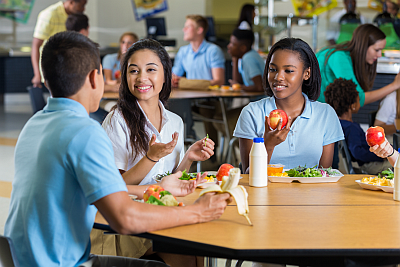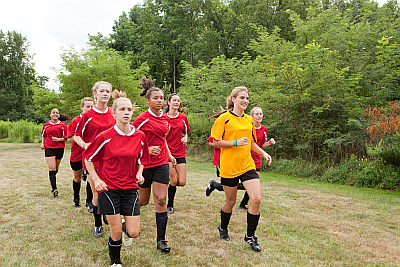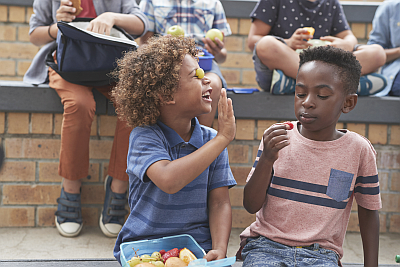The promise of a new school year—can’t you just feel it in the air? With the change in season, you may be thinking about how best to set your child up for success in the classroom.
Learning to lead a healthy lifestyle is one of the best lessons we can teach our children, whether they are heading off to kindergarten or their senior year of high school.

“From the cafeteria menu to gym class, schools are helping K-12 students eat well and move more,” says Aramark Registered Dietitian Nutritionist and Food Service Manager Colleen Tweedy (left). “These good habits help them be their best at school and retain what they learn.”
As teachers, administrators, parents, extended family, and guardians, we all play a role. Not sure where to start at home? “It’s easier than you think to get the whole family on board. It all comes down to some universal truths,” Colleen says.
Drawing on years of working with children and nutrition, she shares some foundational ideas about feeding their potential—and tips for bringing these ideas to life at home.
1. Children look to you as their role model.
“No matter if you have a young one who still wants to be just like you or a semi-rebellious teenager, you can still set an example as a parent,” explains Colleen. Remember, you’re largely in control of the family schedule and what food is available in the house. Practice what you preach, and the whole family will benefit. “I call it, ‘Do as I do AND as I say,’” Colleen adds.

Give them a portion of your grown-up meals instead of making a separate menu. Show them that you practice self-care by getting enough sleep, exercising regularly, and powering up with healthful food.
2. Children will eat healthy foods—if we introduce them.
No matter the meal, expanding their tastes will give your crew a leg up on life. There’s nothing more fun and rewarding than watching a child try something healthy and say, “Hey, that’s good!”
Expose them to different flavors by trying new ingredients at home. Your local supermarket is a great place to start, so commit to picking up one new piece of produce each trip. Put it in a recipe they already know and love—like homemade veggie pizza—to increase your chances of success. (Here are a few ideas for fall to get you started.)
“It may take a few attempts for a new food to stick, so try to remain patient,” says Colleen. “Sometimes, young children and teenagers can make quick progress while it may take weeks or months for others. Be sure to provide consistent opportunities to try new things and show support once they’re ready to explore.”
3. Children LOVE to help in the kitchen.

“Your family will feel more invested in healthy eating if they play a part in it,” Colleen tells us. “They’ll also learn necessary cooking skills to bring into adulthood. It’s always important to know how to properly cut a pepper or the best way to wash produce!”
From meal planning and shopping, to setting the table and light chopping, choose age-appropriate tasks your children can contribute. Have a new driver in the house? A quick grocery run might be the perfect practice. With younger children, you can add kitchen tasks to a chore chart and rotate responsibilities among the team—such as “Today is Tyler’s turn to make the salad, and next time it’ll be Kelly’s turn.”
Bonus: They might even learn lessons about math and manners along the way!
4. Children enjoy family routines.
Whether it’s eating dinner at 6:00 p.m. every night or scheduling can’t-miss Sunday breakfast, structure is a key part of a healthy lifestyle. Food may be the main attraction, but spending time with others will be a highlight too—helping you all slow down and practice being present.
“This is where children can connect with their families and enjoy the communal aspect of food,” says Colleen. “These traditions can form some of the fondest childhood memories. As they grow up, this is a great time to check in on what’s going on in their world.”
5. Children need to move. And move some more.

Recess isn’t just for fun—it has a real purpose. “Regular exercise has important health benefits,” Colleen points out. “Plus, children need to burn all of that energy. Sports and other activities start to take over as they age.”
From the monkey bars to the soccer field, whatever your family enjoys is the right move. Let the little ones get their wiggles out in the backyard or on the local playground or challenge your middle- and high-schoolers to a free-throw tournament—just don’t stay on the sidelines! Remember to pack those water bottles for healthy hydration, especially in hot weather.
6. Children are VERY curious.
Any parent or teacher knows that children can be an endless source of questions (we repeat: endless!). Why not channel that interest into lifelong knowledge?
Start by teaching your family where their food comes from. Understanding that items don’t magically appear on store shelves can help them develop a strong respect for the fuel that food brings and the people who make it possible. From there, you can get excited about regional and hometown flavors and try your hand at new healthy recipes.
You can also share basic nutrition information to help children make the food-function connection. “For example, you could tell them ‘The vitamin C in this orange helps our immune system, so our bodies can fight germs,’” suggests Colleen. “Meanwhile, teens will get a kick out of learning their snack of whole-grain crackers gives them long-lasting energy for afternoon practice.”
7. Children just want to have fun!

Remember ants on a log? “Food is just a little more fun when it comes in a silly shape or has a cute name,” mentions Colleen. “It has a way of opening their minds to new foods and experiences.”
A quick extra step can make all the difference. Whip out your holiday cookie cutters for sandwiches and sliced fruits and vegetables. Any protein-packed lunch can also be fiber-filling, fun and nutritious if wrapped inside a whole-grain tortilla and cut into pinwheel bites! And never underestimate the power of a tasty dip like hummus or salsa: You’ll watch those baby carrots disappear.
Ready, Set, Go!
Everything children do is powered by good nutrition and good health—lessons they can learn at any age. Embrace these ideas, knowing that you are finding new ways to connect and give them a strong foundation for life.
Join Feed Your Potential 365 for year-round recipes, tips, and nutrition news from our expert chefs and dietitians as well as trusted sources like the American Heart Association!
Note: Since everyone’s health history and nutritional needs are so different, please make sure that you talk with your doctor and a registered dietitian to get advice about the diet and exercise plan that‘s right for you.

